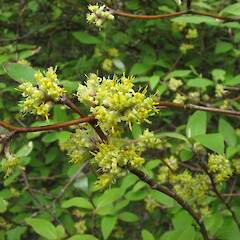Olearia fragrantissima
Common name
fragrant tree daisy
Synonyms
None
Family
Asteraceae
Flora category
Vascular – Native
Endemic taxon
Yes
Endemic genus
No
Endemic family
No
Structural class
Trees & Shrubs - Dicotyledons
NVS code
The National Vegetation Survey (NVS) Databank is a physical archive and electronic databank containing records of over 94,000 vegetation survey plots - including data from over 19,000 permanent plots. NVS maintains a standard set of species code abbreviations that correspond to standard scientific plant names from the Ngä Tipu o Aotearoa - New Zealand Plants database.
OLEFRA
Chromosome number
2n = 108
Current conservation status
The conservation status of all known New Zealand vascular plant taxa at the rank of species and below were reassessed in 2017 using the New Zealand Threat Classification System (NZTCS) – more information about this can be found on the NZTCS website. This report includes a statistical summary and brief notes on changes since 2012 and replaces all previous NZTCS lists for vascular plants.
Please note, threat classifications are often suggested by authors when publications fall between NZTCS assessment periods – an interim threat classification status has not been assessed by the NZTCS panel.
- Conservation status of New Zealand indigenous vascular plants, 2017 . 2018. Peter J. de Lange, Jeremy R. Rolfe, John W. Barkla, Shannel P. Courtney, Paul D. Champion, Leon R. Perrie, Sarah M. Beadel, Kerry A. Ford, Ilse Breitwieser, Ines Schönberger, Rowan Hindmarsh-Walls, Peter B. Heenan and Kate Ladley. Department of Conservation. Source: NZTCS and licensed by DOC for reuse under the Creative Commons Attribution 4.0 International licence.
2017 | At Risk – Declining | Qualifiers: PD
Previous conservation statuses
2012 | At Risk – Declining | Qualifiers: PD
2009 | At Risk – Declining | Qualifiers: CD, PD
2004 | Sparse
Brief description
Small bushy shrub with many erect reddish brown zig-zagging twigs and sweet smelling small flowers inhabiting coastal areas from Banks Peninsula to Invercargill. Leaves 7.5-30mm long by 5-10mm wide, pointed, hairy when young. Flowers yellow, in small tight clusters. Seeds fuzzy.
Distribution
Endemic, eastern and south-eastern South Island from Banks Peninsula to Southland.
Habitat
coastal to lower montane (0-300 m a.s.l.) usually in grey scrub, on forest margins or shrublands. Sometimes on the margins of estuarine or saltmarsh vegetation in places which would be subject to saline water in extremes of tide, also found on gravelly soils often on the margins of steep gullies, gorges and in boulder field.
Detailed description
Small semi-deciduous tree up to 8 m tall. Trunk stout, up to 0.6 m d.b.h., clad in greyish-brown bark, this long persistent peeling in long flaking strips. Branches dark reddish brown ascending to spreading; branchlets reddish-brown to red, rigidly wiry, flexuous (often zig-zagging), interlacing, striate. Petioles up to 3 mm long, red-brown. Leaves alternate, 7.5-40 x 5-15 mm, yellow-green to bright green, elliptic-oblong, elliptic-ovate or broad-ovate to obovate, apex obtuse to acute, base cuneate to attentuate; lamina membranous, upper surface glabrate to galbrous when mature, undersides clad in soft, white tomentum, margins flat, entire. Inflorescences axillary (never terminal) in sessile to subsessile glomerules up to 20 mm diameter, each bearing up to 12 bracteate capitula. Capitula 2-4 mm diameter, strongly fragrant (especially at night); involucral bracts bi- to triseriate, oblong under sides copiously white-tomentose; florets 4-8, pale yellow to orange-yellow, ray-florets 1.5-2 x 1.5-2 mm, pale yellow. Cypsela 2 mm long, slightly compressed, grooved, finely and sparsely pilose hairy; pappus 2-3 mm long, pale yellow to buff.
Similar taxa
Olearia hectorii Hook.f. is somewhat similar but this species has opposite, broadly-elliptic, grey-green leaves that are finely hairy on both surfaces. It usually forms a much larger tree (up to 10 m tall), has distinctive deeply furrowed, long persistent grey to greyish-white bark, and branchlets are never flexuous and interlacing. In lowland areas Olearia hectorii tends to grow on poorly drained alluvial soils.
Flowering
October - February
Flower colours
Orange, Yellow
Fruiting
November - April
Propagation technique
Easily grown from semi-hardwood cuttings that are best taken in autumn and held in a cold frame, and from fresh seed (seed has short-term viability). Seed responds well to 5-10 days cold treatment prior to sowing. An attractive shrub or small tree for the garden. very tolerant of a range of conditions and once established drought tolerant. The deliciously apricot-peach scented flowers are rather notable and unique to this species.
Threats
A rather widespread species which can be locally common but is more usually sparsely distributed over large parts of its known range. Although threatened in some areas this species does seem to be recruiting naturally at many locations and populations tend to have good age class structure.
Etymology
olearia: Named after Johann Gottfried Olearius, a 17th-century German scholar, writer of hymns and author of Specimen Florae Hallensis
fragrantissima: Deliciously scented
Where To Buy
Occasionally sold by specialist native plant nurseries.
Attribution
Fact Sheet prepared for the NZPCN by P.J. de Lange 14 April 2006. Description adapted from Heads (1998).
References and further reading
Heads, M. 1998. Biodiversity in the New Zealand divaricating tree daisies: Olearia sect. nov. (Compositae). Botanical Journal of the Linnean Society 127(3): 239-285.
NZPCN Fact Sheet citation
Please cite as: de Lange, P.J. (Year at time of access): Olearia fragrantissima Fact Sheet (content continuously updated). New Zealand Plant Conservation Network. https://www.nzpcn.org.nz/flora/species/olearia-fragrantissima/ (Date website was queried)



















